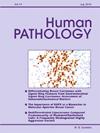乳腺实性基底样腺样囊性癌:一种高度三阴性的乳腺癌,对新辅助化疗很少有反应。
IF 2.7
2区 医学
Q2 PATHOLOGY
引用次数: 0
摘要
乳腺固体基底样腺样囊性癌(SB-AdCC)是一种极其罕见但重要的肿瘤,需要与典型AdCC (C-AdCC)明确区分,以获得最佳治疗。本病例系列回顾性回顾了20例乳腺adcc的诊断和治疗。虽然四位乳腺病理学家对所有c - adcc的诊断达成了共识,但在诊断纯sb - adcc时存在相当大的分歧。SB-AdCC的形态和免疫组织化学特征与基底细胞样三阴性乳腺癌(TNBC)非常相似。SB-AdCC的分子分析揭示了Notch通路的频繁突变和染色质修饰因子(如CREBBP和KMT2D)的改变。MYB-NFIB融合很少见,在9例sb - adcc中仅检测到2例(22.2%)。10例SB-AdCC患者中有2例在手术时出现腋窝淋巴结转移。在27个月的中位随访期间,有1例SB-AdCC患者出现腋窝复发。此外,12例SB-AdCC患者中有6例(50.0%)发生远处转移。在接受SB-AdCC新辅助化疗的3名患者中,1名患者获得了接近完全的病理反应,而其余2名患者的反应最小。总之,这个系列强调了SB-AdCC的侵袭性临床过程,类似于传统的TNBC。病理上,SB-AdCC也与传统TNBC相似。病理学家必须明确指出C-AdCC或SB-AdCC或给出每种成分的百分比,以确保适当的治疗策略,避免过度治疗和治疗不足。本文章由计算机程序翻译,如有差异,请以英文原文为准。
Solid basaloid adenoid cystic carcinoma of the breast: A high-grade triple negative breast carcinoma which rarely responds to neoadjuvant chemotherapy
Solid basaloid adenoid cystic carcinoma of the breast (SB-AdCC) is an exceedingly rare but important entity that warrants clear separation from classic AdCC (C-AdCC) for optimal treatment. This case series retrospectively reviewed the diagnosis and treatment of 20 breast AdCCs. While four breast pathologists reached consensus on the diagnosis of all C-AdCCs, there was considerable disagreement when diagnosing pure SB-AdCCs. The morphology and immunohistochemical profiles of SB-AdCC closely resemble those of basaloid triple-negative breast carcinoma (TNBC). Molecular profiling of SB-AdCC revealed frequent mutations in the Notch pathway and alterations in chromatin modifiers, such as CREBBP and KMT2D. MYB-NFIB fusion was rare and detected in only 2 of 9 (22.2 %) SB-AdCCs. Axillary lymph node metastasis was present in 2 of 10 patients with SB-AdCC at the time of surgery. During a median follow-up of 27 months, one patient with SB-AdCC developed axillary recurrence. Moreover, 6 of 12 (50.0 %) patients with SB-AdCC developed distant metastases. Of the three patients who underwent neoadjuvant chemotherapy for SB-AdCC, one achieved near-complete pathological response, while the remaining two had minimal response. In conclusion, this series underscores the aggressive clinical course of SB-AdCC, similar to conventional TNBC. Pathologically, SB-AdCC also closely mimics conventional TNBC. It is imperative for pathologists to clearly indicate C-AdCC or SB-AdCC or give a percentage of each component to ensure appropriate treatment strategies and avoid both over-treatment and under-treatment.
求助全文
通过发布文献求助,成功后即可免费获取论文全文。
去求助
来源期刊

Human pathology
医学-病理学
CiteScore
5.30
自引率
6.10%
发文量
206
审稿时长
21 days
期刊介绍:
Human Pathology is designed to bring information of clinicopathologic significance to human disease to the laboratory and clinical physician. It presents information drawn from morphologic and clinical laboratory studies with direct relevance to the understanding of human diseases. Papers published concern morphologic and clinicopathologic observations, reviews of diseases, analyses of problems in pathology, significant collections of case material and advances in concepts or techniques of value in the analysis and diagnosis of disease. Theoretical and experimental pathology and molecular biology pertinent to human disease are included. This critical journal is well illustrated with exceptional reproductions of photomicrographs and microscopic anatomy.
 求助内容:
求助内容: 应助结果提醒方式:
应助结果提醒方式:


